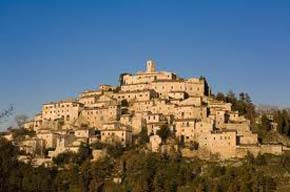


Labro lies on a hill overlooking the Fuscello valley and the Piediluco lake while behind it is dominated by the Terminillo mountain range. Tourists strolling through the winding streets of Labro will enjoy these landscapes by glancing at windows that suddenly open up between the houses made of stone and by reaching the belvedere at the top of the town.
Labro is part of the province of Rieti (Lazio) and is bordered to the North-East with the Province of Terni (Umbria).
The old houses, the noble palaces have been restored in recent years by the architect Ivan Van Mossevelde: thanks to this architect the unmistakable silhouette stands out again, in the blue, with its original skyline.
The town includes the villages of: Acquacogna, Colle Sorbo, Colle di Mezzo, Colle Rucciolo, Madonna della Luce, Collicelle, Macchie Basse, Macchie Alte, Colle del Lupo, Colle Sterleta, Collelungo, Case Tolla and Valle Avanzana.
information taken from Comune di Labro
Labro is part of the province of Rieti (Lazio) and is bordered to the North-East with the Province of Terni (Umbria).
The old houses, the noble palaces have been restored in recent years by the architect Ivan Van Mossevelde: thanks to this architect the unmistakable silhouette stands out again, in the blue, with its original skyline.
The town includes the villages of: Acquacogna, Colle Sorbo, Colle di Mezzo, Colle Rucciolo, Madonna della Luce, Collicelle, Macchie Basse, Macchie Alte, Colle del Lupo, Colle Sterleta, Collelungo, Case Tolla and Valle Avanzana.
information taken from Comune di Labro
The origin of the name of the town is still unclear; some believe it derives from the Latin "aper” or “aprum" which means boar: according to a legend, the first fortress was built by a nobleman from Rieti, Lord De ' Nobili, who during a hunting trip made a promise to build a castle in the place where he would have shot down his first wild boar. To honour this legend, Labro’s coat of arms pictures a wild boar under an oak tree.
Others though sustain the hypothesis of the derivation from the Latin word "lavabrum" which means " bath” or “basin"; this would be a more obvious explanation due to the proximity to the town and lake of Piediluco, once much more extended and probably even reaching the town of Labro itself.
From the tenth century AC we have the first information regarding the district and the castle of Labro, built by an aristocratic family in the likeness of the Spoleto fortress. In the year 956 begins the feudal history of the town: the Holy Roman Emperor Otto I appoints Aldobrandino De’ Nobili as the lord of Labro and gives him, in addition to the above title, the lordship of 12 other castles located between the duchy of Spoleto and the area of Rieti.
The medieval period was certainly not a quiet time for Labro! On the contrary, precisely because of the many struggles carried out during this period, the town developed a fighting reputation. The inhabitants often fought against nearby castles and in particular against the fortress of Luco. Precisely because of one of these wars, the De’ Nobili family ended up loosing, in the second half of the fifteen century, the lordship of Labro with its impregnable castle, which stood at the top of the town and included a high tower from the top of which they could view all central Italy.
The family donated in the twelfth century the fourth part of Labro to S. John Lateran in order to receive in return a support in the fight against the Normans, who reached the edge of Morro at the peak of their splendor. The ancient noble family was therefore left with the city castle walls; in the sixteenth century, Jordan De ' Nobili built a palace leaning against these walls which can still be admired today and which still belongs to the Nobili Vitelleschi family.
The structure of the town follows the course of the sun, descending from the top of the hill into well-defined bands. The first – which is also the oldest - is the one of the castle and the tower and is oriented towards the east; after that you can notice the band of the noble palaces followed by the one of the ordinary people.
These three main sections, joined together by secondary routes excavated in the rock, clearly represent Labro’s historical and social development: the lower path serves a range of mostly single-family homes of artisans or peasants. The middle part includes larger buildings, whereby the higher path has been built to access the castle, which is built on the highest part of the hill. This appearance remained intact to this day and even earthquakes or wars have failed to leave their mark.
During the Second World War there was a reprisal and fifty men from Labro were put against the wall to be executed. Thanks to the intervention of the Marquise Mary Jane, who was able to negotiate in German with the soldiers, they were all spared in the end.
After the war, due to depopulation, Labro was in danger of being abandoned together with its heritage. Unlike many other medieval villages though, Labro managed to preserve the town thanks to its citizens’ awareness of the importance of their history and traditions. That’s why we can still admire the original buildings and the castle up until today.
information taken from Comune di Labro
Others though sustain the hypothesis of the derivation from the Latin word "lavabrum" which means " bath” or “basin"; this would be a more obvious explanation due to the proximity to the town and lake of Piediluco, once much more extended and probably even reaching the town of Labro itself.
From the tenth century AC we have the first information regarding the district and the castle of Labro, built by an aristocratic family in the likeness of the Spoleto fortress. In the year 956 begins the feudal history of the town: the Holy Roman Emperor Otto I appoints Aldobrandino De’ Nobili as the lord of Labro and gives him, in addition to the above title, the lordship of 12 other castles located between the duchy of Spoleto and the area of Rieti.
The medieval period was certainly not a quiet time for Labro! On the contrary, precisely because of the many struggles carried out during this period, the town developed a fighting reputation. The inhabitants often fought against nearby castles and in particular against the fortress of Luco. Precisely because of one of these wars, the De’ Nobili family ended up loosing, in the second half of the fifteen century, the lordship of Labro with its impregnable castle, which stood at the top of the town and included a high tower from the top of which they could view all central Italy.
The family donated in the twelfth century the fourth part of Labro to S. John Lateran in order to receive in return a support in the fight against the Normans, who reached the edge of Morro at the peak of their splendor. The ancient noble family was therefore left with the city castle walls; in the sixteenth century, Jordan De ' Nobili built a palace leaning against these walls which can still be admired today and which still belongs to the Nobili Vitelleschi family.
The structure of the town follows the course of the sun, descending from the top of the hill into well-defined bands. The first – which is also the oldest - is the one of the castle and the tower and is oriented towards the east; after that you can notice the band of the noble palaces followed by the one of the ordinary people.
These three main sections, joined together by secondary routes excavated in the rock, clearly represent Labro’s historical and social development: the lower path serves a range of mostly single-family homes of artisans or peasants. The middle part includes larger buildings, whereby the higher path has been built to access the castle, which is built on the highest part of the hill. This appearance remained intact to this day and even earthquakes or wars have failed to leave their mark.
During the Second World War there was a reprisal and fifty men from Labro were put against the wall to be executed. Thanks to the intervention of the Marquise Mary Jane, who was able to negotiate in German with the soldiers, they were all spared in the end.
After the war, due to depopulation, Labro was in danger of being abandoned together with its heritage. Unlike many other medieval villages though, Labro managed to preserve the town thanks to its citizens’ awareness of the importance of their history and traditions. That’s why we can still admire the original buildings and the castle up until today.
information taken from Comune di Labro
The castle of Labro, as a fief, is part of that group of fortified settlements, built by the aristocracy between the X and XI century on the south-western slopes of the Terminillo mountain range. The castle of Labro in particular, was built by the Nobili family. The sources relating to the history of the Nobili Vitelleschi family are based on information supplied from the archive of the family, from the manuscript "History of Labro" by the notary Tabulazzi Ippolito (1630), from the work of Michele Michaeli "Historical memoirs of the city of Rieti and of the neighboring towns" and from the Archives of the history of Italy (Rieti).
The origins of the family seem to be Longobardic. In fact, " ... the secondary branches of the Counts of the Marsi and Rieti were the lords of the Berardesc lands, from which the families Nobili from Labro, Castelli from Terni , Arroni and maybe even Alfani from Rieti originate." (Michaeli, Vol. II, p. 169). The Counts of the Marsi and Rieti were branches of the Lombards Dukes of Spoleto. In the year 956, the lords of Labro received by the Emperor Otto I the coat of arms with the crowned eagle and the fish (symbol of the rule of their castles over lakes and rivers) and the induction of 12 feuds among which the castle of Labro (Tabulazzi, p. 44).
The news about the first 5 generations are not genealogically clear so here are only the most representative names of Labro’s lords: Arrone, Ercole, Corrado Berardo II and Pandolfo, quoted because of his death in battle in 1265, in the wake of King Manfred (Tabulazzi , p. 98). Later, from Sinibaldo Lord of Labro (1220), through documents such as the "Instrumenta" (Archive Nobili Vitelleschi, Labro) it was possible to establish the genealogy of the family to this day. The surname Nobili is derived from the nickname used to describe the lords of Labro (nobile in Italian means aristocrat, lord). From the mid-fourteenth to the end of the seventeenth century the Nobili of Labro were in charge of public positions as part of Rieti’s government.
The castle of Labro consisted of a large, very high, square tower around which the village was built. This was surrounded by a street, in turn, protected by the walls including other seven towers, guard posts and structures of various types . At the end of 1400, following the excommunication by Pope Sixtus IV, for the murder of a priest at the hands of Giovanni de ' Nobili, the family was punished with the destruction of the great tower and the village. The inhabitants built in 1498 - on part of the main tower’s foundations - a small church with a beautiful portal, which can still be admired in the upper part of Labro today. The family de ' Nobili was left with the outer part of the castle: the walls, the towers and the guard posts. They therefore decided to adapt those constructions to build their new palace, which the family will occupy until today.
In 1575, Girolamo de ' Nobili married Virginia Vitelleschi. With the death of her nephew Sante, son of her brother Marcantonio, Virginia was the last left of her family. At the request of older family members, the children of Girolamo and Virginia were given a double surname (Nobli and Vitelleschi) and a joined emblem with both the eagle and the fish (Nobili) as well as the lilies and the calves (Vitelleschi). The act that officially sanctioned the union of surnames and coats of arms is preserved in the archives of the Capitol. A certified copy is located in the Archive Nobili Vitelleschi in Labro.
information taken from Comune di Labro
The origins of the family seem to be Longobardic. In fact, " ... the secondary branches of the Counts of the Marsi and Rieti were the lords of the Berardesc lands, from which the families Nobili from Labro, Castelli from Terni , Arroni and maybe even Alfani from Rieti originate." (Michaeli, Vol. II, p. 169). The Counts of the Marsi and Rieti were branches of the Lombards Dukes of Spoleto. In the year 956, the lords of Labro received by the Emperor Otto I the coat of arms with the crowned eagle and the fish (symbol of the rule of their castles over lakes and rivers) and the induction of 12 feuds among which the castle of Labro (Tabulazzi, p. 44).
The news about the first 5 generations are not genealogically clear so here are only the most representative names of Labro’s lords: Arrone, Ercole, Corrado Berardo II and Pandolfo, quoted because of his death in battle in 1265, in the wake of King Manfred (Tabulazzi , p. 98). Later, from Sinibaldo Lord of Labro (1220), through documents such as the "Instrumenta" (Archive Nobili Vitelleschi, Labro) it was possible to establish the genealogy of the family to this day. The surname Nobili is derived from the nickname used to describe the lords of Labro (nobile in Italian means aristocrat, lord). From the mid-fourteenth to the end of the seventeenth century the Nobili of Labro were in charge of public positions as part of Rieti’s government.
The castle of Labro consisted of a large, very high, square tower around which the village was built. This was surrounded by a street, in turn, protected by the walls including other seven towers, guard posts and structures of various types . At the end of 1400, following the excommunication by Pope Sixtus IV, for the murder of a priest at the hands of Giovanni de ' Nobili, the family was punished with the destruction of the great tower and the village. The inhabitants built in 1498 - on part of the main tower’s foundations - a small church with a beautiful portal, which can still be admired in the upper part of Labro today. The family de ' Nobili was left with the outer part of the castle: the walls, the towers and the guard posts. They therefore decided to adapt those constructions to build their new palace, which the family will occupy until today.
In 1575, Girolamo de ' Nobili married Virginia Vitelleschi. With the death of her nephew Sante, son of her brother Marcantonio, Virginia was the last left of her family. At the request of older family members, the children of Girolamo and Virginia were given a double surname (Nobli and Vitelleschi) and a joined emblem with both the eagle and the fish (Nobili) as well as the lilies and the calves (Vitelleschi). The act that officially sanctioned the union of surnames and coats of arms is preserved in the archives of the Capitol. A certified copy is located in the Archive Nobili Vitelleschi in Labro.
information taken from Comune di Labro










